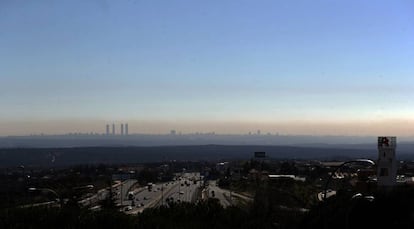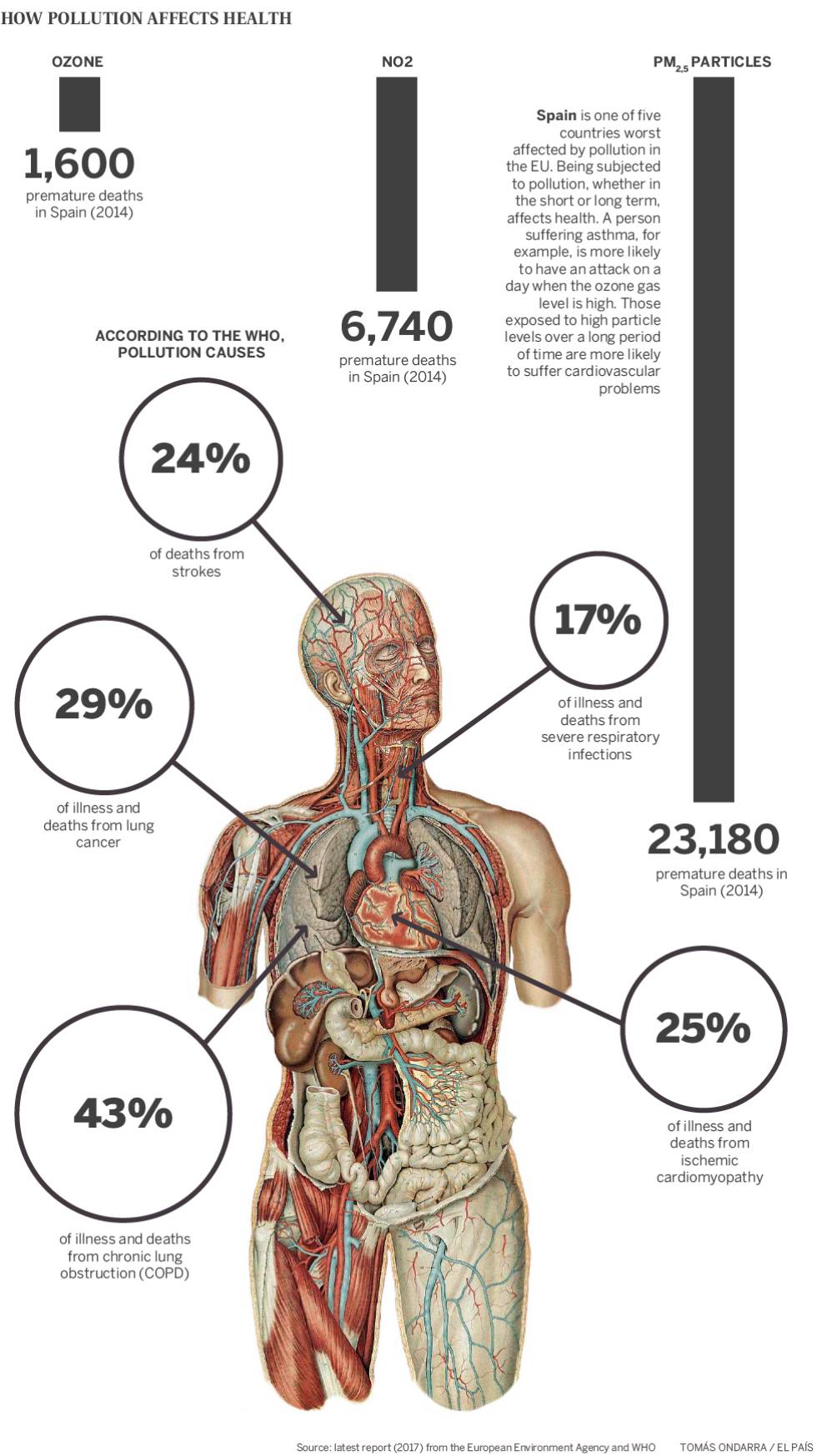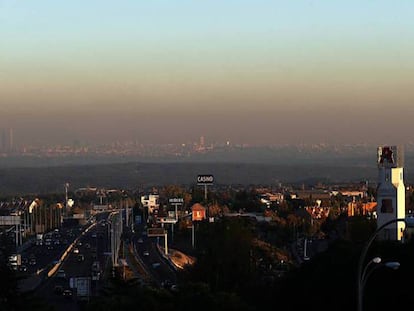15 million Spaniards are breathing air the EU considers polluted
More than half of Spain is wreathed in air containing excessive levels of particulate matter, nitrogen dioxide and ozone

A pedestrian in Toledo is breathing polluted air from a traffic jam in MadridˇŻs Gran V¨Şa avenue. And in the Sierra Norte, outside of Madrid, hundreds of people from the capital spend their weekends thinking they are enjoying fresh air without realizing it was one of the most polluted areas in Spain last year.
Meanwhile, other rural areas such as the Plain of Vic in Catalonia and villages like Villanueva del Arzobispo in Ja¨¦n, in Andalusia, have levels of contamination that break EU air quality regulations.
These are just a few of the pollution paradoxes that are adversely affecting the health of at least 15 million people in Spain, according to EL PA?S estimates. The most severely affected areas are Madrid and Barcelona but the regions of Andalusia, Extremadura, Castilla-La Mancha and Valencia are also battling with high-risk levels.
Spain is plagued by three main pollutants: nitrogen dioxide (NO2), caused by traffic and predominantly a problem in big cities; PM10 particulate matter, consisting of dust, ash, soot and similar substances produced by traffic as well as central heating systems, industry and construction; and finally ozone, a pollutant linked to the others, which is prevalent during hot weather and can spread long distances ¨C which is why areas where the air might be assumed to be clean, such as MadridˇŻs Sierra Norte, can be highly contaminated.
Road traffic is responsible for more than 50% of NO2 emissions, particularly diesel vehicles
EL PA?S has calculated the number of those affected using the latest data from 2017 from the Ministry for Ecological Transition, taking into account the size of the population living in the areas where any of the three pollutants exceed EU limits.
Each of the zones contains one or more air quality monitoring stations. For the zone to fail to meet legal requirements, it only needs one of the stations to exceed the legal limit. In the largest or most populated regions such as Andalusia, it is quite common for most stations to record acceptable levels with only one breaking the law.
The environmental organization Ecologists in Action, using its own methodology, puts the number of people in Spain affected by poor air quality last year at 17.5 million. Meanwhile, the Ministry for Ecological Transition insists it is impossible to measure the effects on health with any precision. It does say, however, that it would produce data relating to health if it had population figures for the areas covered by each station, but this information is in the hands of each region.
As far as the government is concerned, the preliminary data on pollution levels from 2018 shows ˇ°a certain improvement,ˇ± particularly with respect to NO2. The climate has helped, as there has been more wind and rain. ˇ°It makes us think that the measures taken by the authorities are working,ˇ± says a government spokesman.
But Miguel ?ngel Ceballos from Ecologists in Action is skeptical. While he recognizes that the situation was worse before the economic crisis, he claims: ˇ°The [economic] recovery has been triggering the problem again since 2015, with an increase in the burning of fossil fuels and the consequent emissions.ˇ± He adds that the authorities are not adopting adequate measures to reverse this.
The Ministry for Ecological Transition does, however, recognize that in 2017, the balance was negative, meaning the quality of air was worse than the year before.
Nitrogen Dioxide (NO2)
The hotspots for NO2, a pollutant largely associated with volume of traffic, are big cities and their outlying areas, such as Madrid, Barcelona and Granada as well as Bilbao. NO2 is a byproduct of combustion at high temperatures, for instance in car motors and electricity plants.
According to data from the Inventory of Contaminating Emissions in MadridˇŻs Atmosphere, road traffic is responsible for more than 50% of NO2 emissions, particularly diesel vehicles.
During pregnancy, breathing polluted air can affect the development of the fetus. It is also potentially carcinogenic Lung specialist Ram¨®n Fern¨˘ndez
In Granada, where traffic is less dense than in Madrid and Barcelona, the pollution problem is exacerbated by geography and climate, according to ministry experts. The city is located in a valley surrounded by mountains that trap the pollution in winter, when the colder, polluted air cannot rise and disperse due to a lid of warm air. Central heating systems and the burning of crop stubble in the agricultural region of La Vega further aggravate the situation. And the weak winds particular to the region do nothing to mitigate the problem.
To protect our health, the EU stipulates that the annual average of NO2 should not exceed 40 micrograms per cubic meter. In Madrid, 62 micrograms were registered last year ¨C 55% over the limit; and in Barcelona, the figure was 59?micrograms ¨C 47.5% over.
There is a second emergency limit linked to spikes of NO2 which are common in Madrid and which happen when the air is stagnant. The capital was the only place in Spain that exceeded this emergency limit last year, which is set at 200 micrograms per cubic meter an hour, no more than 10 times during the year. Madrid was six times over the limit on 62 occasions. One station called Fern¨˘ndez Ladreda, which measures air quality at one of the main entry points to Madrid from the south, recorded 88 hours when the limit was breached.
PM10 particulates
The problem with PM10 particulates is more spread out. ItˇŻs not a big problem in big cities but it is increasingly affecting Granada and its outlying areas, as well as M¨˘laga, the entire Costa del Sol and Avil¨¦s in Asturias, not to mention rural areas such as the Plain of Vic and the village of Villanueva del Arzobispo in Ja¨¦n province.
PM10 particulate matter consists of dust, ash, soot and other non-organic components measuring between 2.5 and 10 micrograms in diameter. They are usually caused by central heating systems, construction and demolition works but traffic can also be a source.
Of the 126 zones in Spain, 36 have illegal levels of ozone gas
In Granada, two air quality stations measured ratios of PM10 above the EU limit that, according to experts, are caused equally by traffic, heating and building works. An inventory of 1,460 boilers carried out by the council this year revealed that 1,044 ¨C or 62.93% ¨C? use diesel, which is a highly contaminating fuel. Meanwhile, 371 use natural gas, 27 biomass and 18 propane gas. In the M¨˘laga area, the problem was worst in Marbella due to the volume of traffic in the city.
Ozone gas
The ozone layer protects the planet but ozone gas at ground level is very polluting and it is hard to tackle because it appears where it is least expected.
It forms as a result of the other pollutants when there is strong solar radiation on the earthˇŻs surface. It is also blown long distances by the wind. On the Mediterranean coastline, for example, the wind blows contamination inland during the day and out to sea at night. Further inland, the wind blows the ozone gas from the center of Madrid to Castilla y Le¨®n and to Castilla-La Mancha.
Of the 126 zones in Spain, 36 have excessive levels of ozone gas. The more cars and pollution in the cities, the bigger the ozone problem in the outlying areas. Sierra Norte in the region of Madrid was one of the worst hit areas. In this area, which covers 1,952 kilometers and is home to 110,000 people, two municipalities ¨C El Atazar and Guadalix de la Sierra ¨C violated recommended levels. The levels are breached when they go above 120 micrograms per cubic meter over a period of eight hours more than 25 times a year. In the Sierra Norte, this happened 68 times.
La Cuenca del R¨Şo Taju?a, an area with a population of 45,171 in the region of Madrid, also broke the limits as did the area in Andalusia that groups towns of 50,000 to 250,000 inhabitants ¨C the worst hit being Las Fuentezuelas and Ronda del Valle in Ja¨¦n. The outskirts of C¨®rdoba were also over the limit, according to the Asomadilla monitoring station.
Federico Vel¨˘zquez de Castro, a doctor in chemical science, explains that while the whole of Spain has a problem with ozone gas, Andalusia has the highest levels due to solar radiation and high temperatures. The ozone gas on the coast near Granada may well have been blown by the wind from as far as the petrochemical plant in Tarragona.
Health impact

Be it due to one or all of the pollutants, more than half of Spain does not meet EU air quality regulations. ˇ°Breathing polluted air affects our respiratory system in a number of ways,ˇ± says Ram¨®n Fern¨˘ndez, a specialist in environmental issues for the Spanish Lung Society (Separ). ˇ°It aggravates chronic respiratory diseases such as asthma or COPD [chronic obstructive pulmonary disease] and can lead to hospitalization. It can also trigger vascular problems, such as strokes and heart attacks. During pregnancy, it can cause breathing problems that affect the development of the fetus. It is also potentially carcinogenic.ˇ±
ˇ°Lately, there has been a big drop in the density of particles but all pollution at high levels is potentially damaging,ˇ± says Fern¨˘ndez, who adds that while pollution enters the body through our respiratory system, it moves quickly into other areas. ˇ°These particles are able to penetrate our circulation, triggering inflammatory mechanisms that damage different organs. The worst affected are the lungs, the heart and the blood vessels,ˇ± he says.
Studying the effects of pollution on the health is challenging. Poor air quality never features as the cause of death on a death certificate. The effects are accumulative and there is no obvious cause and effect.
According to the most recent annual report from the European Environment Agency (EEA), 38,600? premature deaths in Spain in 2015 were due to pollution and 27,900 of these were caused by particulate pollution. Meanwhile, different studies have shown there is a direct correlation between the numbers of hospital admissions and spikes in pollution.
English version by Heather Galloway.

